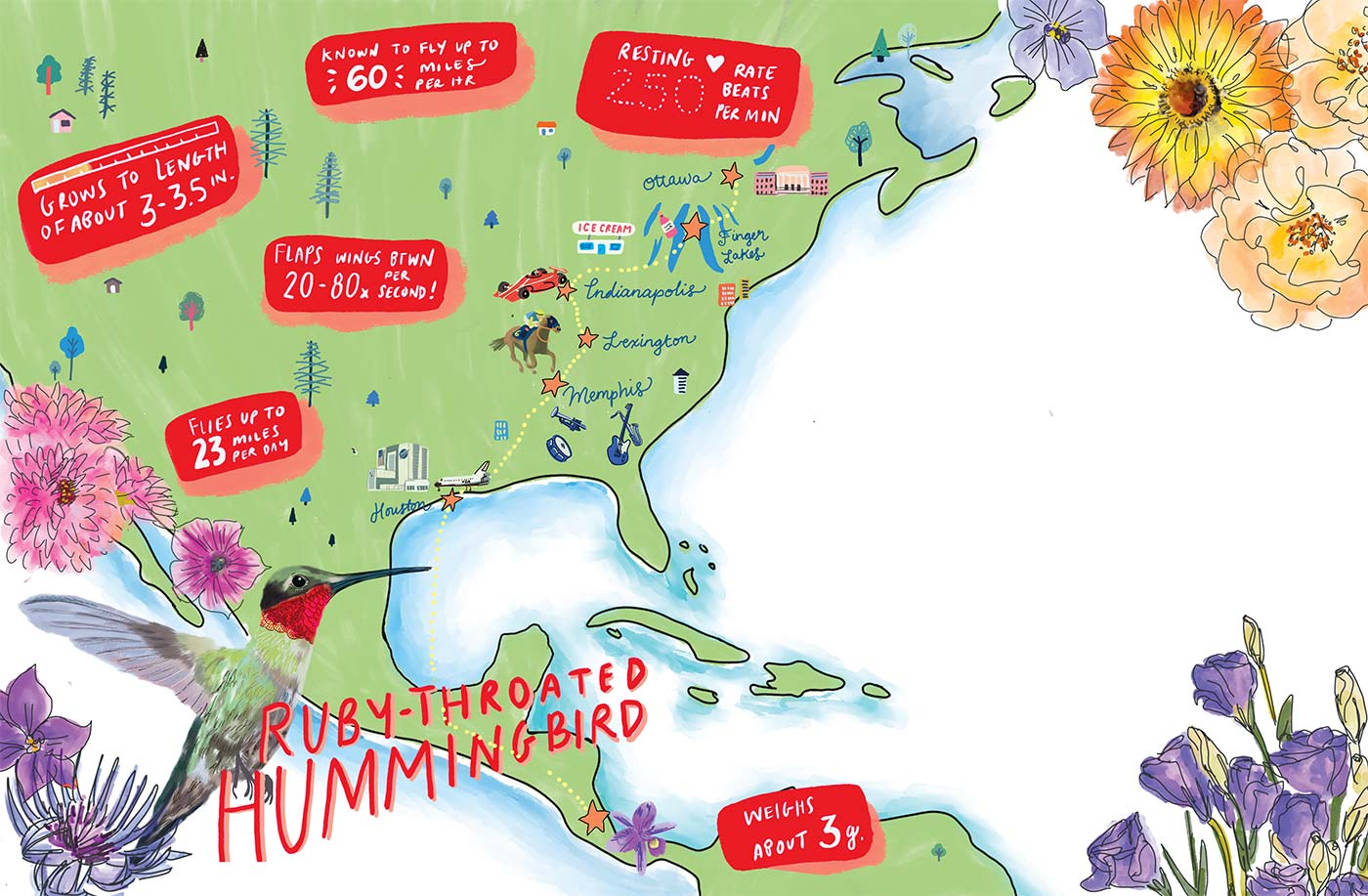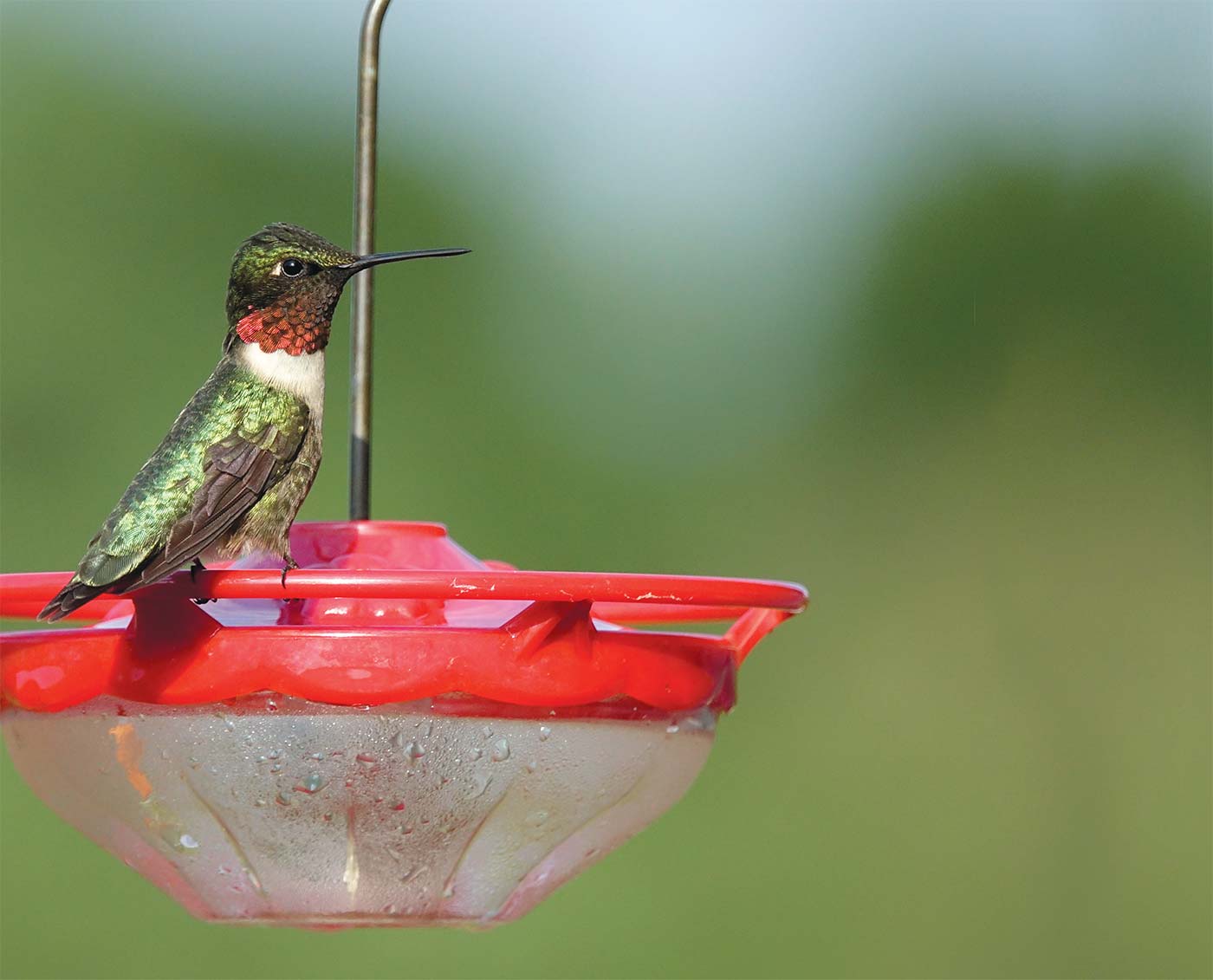Dazzling Dynamos
Because hummingbirds feed upon nectar from flowers, sugar water from feeders, and small insects, they may stop over on their journey for a few minutes or days when they find food available for fuel. This is why landscaping our yards with their favorite flowering plants and providing feeders can be helpful.
As hours and warmth of sunlight increase, the flowers bloom, the insects become active and our ruby-throated hummingbirds (Archilochus colubris) return to the eastern United States during spring migration. They travel thousands of miles to spend summer here, to breed and raise their young.
Migration, from Central America all the way to Canada, is one of the most incredible feats of this tiny bird that measures 2.8–3.5 inches in length with a wingspan of 3–4 inches and weighs just 0.1–0.2 ounces.
And in fall, they migrate again—south this time. Some individuals will remain in the United States along the Gulf Coast and southern Florida. Most of our hummingbirds spend their winters in Central America and many will fly across the Gulf of Mexico.
Before beginning their migration, they will increase their body weight by 25– 40% for their long journey. Hummingbirds fly alone during the day and will often use the same course they have used previously. They fly low, not far above treetops or bodies of water. These birds, affectionately called hummers, can travel as much as 23 miles in a day. Amazingly, those that traverse the Gulf of Mexico complete the 500-mile flight nonstop, dependent on wind and weather conditions.
First arrivals in spring are usually males with their brilliant iridescent red throat, which can appear dark in poor light. Both sexes have emerald backs and crowns, with grayish-white underparts. The females have white throats and follow a couple of weeks later.
Because hummingbirds feed upon nectar from flowers, sugar water from feeders, and small insects, they may stop over on their journey for a few minutes or days when they find food available for fuel. This is why landscaping our yards with their favorite flowering plants and providing feeders can be helpful.
These early arrivals will benefit from sugar water provided in feeders when weather is still unpredictable and natural food sources are limited. Our hummingbirds usually return to the same feeders and plants each year. Most hummers nest soon after their arrival at feeders unless they are migrating farther north.
Take comfort that you are helping to sustain these birds that return to your property to either fuel up and/or stay to raise their young.
Hummingbirds need to feed constantly during the day to survive. They come close to consuming their body weight in nectar, sugar water and insects every day. Their resting heart rate is 250 beats per minute but during normal flight the rate can rise to 1,300 beats per minute. To get through the night they will conserve energy by becoming torpid. During torpor they slow down their body processes. A hummer’s body temperature drops below 60°, heart rate slows to fewer than 50 beats per minute and breathing can momentarily stop. Although birds are not dependent on our feeders, one can see how important a feeder can be in the early morning for these birds.
How can you best support these incredible friends that return to our homes each year? The strongest impact you can have is to plant colorful native plants in your yards, plant pots and hanging baskets. Examples of native plants to grow are columbine (Aquilegia canadensis), cardinal flower (Lobelia cardinalis), grape honeysuckle (Lonicera reticulata), Indian pink (Spigelia marilandica) and wild bergamot (Monarda fistulosa).
Native plants are critical for the biodiversity of our landscapes and this begins with our yards—even container gardens and hanging plants on an apartment balcony. This biodiversity sustains our ecosystems by benefiting pollinators, native insects, birds and other wildlife. Bringing Nature Home: How You Can Sustain Wildlife with Native Plants by Doug Tallamy (Timber Press, 2009) is an easy read to understand the power we have to make a difference in our environment through the interconnectedness of native plants and wildlife.
Plants and animals are unique and fascinating. It is their adaptations that are so intriguing. Adaptations are those physical characteristics and behaviors that help a plant or animal survive in their environment. For hummingbirds, one of the most fascinating is their flight. Sit at a window and watch them at your feeder and you will be amazed at their acrobatics. They are capable of flying every direction including sideways, shooting upwards, downwards, and stopping to hover. They can even fly upside-down for short distances. As if that was not enough, they are known to fly up to 60 miles per hour and can flap their wings 20–80 times per second during flight. By contrast, most songbirds beat their wings about five times per second.
These flight abilities are the result of the hummingbird’s elongated wings that are stiff and do not bend. Their wings have an oar-like look because of their short flight feathers. While other birds have flexible wings that beat in a “flap and glide” motion, hummingbirds appear to be rowing when they fly.
Another flight adaptation is the ability to create power in both the downstroke and upstroke. Their upper wing bones rotate in the shoulder joint, which allows them to change the angle of the leading edges of their oar-shaped wings.
If you have watched hummingbirds at feeders for very long you undoubtedly observed male ruby-throats aggressively defend the feeders and flowers. This results in spectacular pursuits and dogfights. These territorial aggressions by males are towards all hummingbirds—males, females and juveniles. Feeders are defended by males against all others.
Another fascinating flight behavior is by the male. He performs a courtship display exhibited to females who enter his territory. The male flies in a looping U-shaped dive above the female—as high as 50 feet. It is a treat to witness this behavior.
When it comes to family life, the female does all the work. Male and female rubythroated hummingbirds are together only through courtship and mating, which can be a few days or weeks. In Central and Southern Indiana, they tend to have two broods each year; farther north the tendency is towards one brood. The male then is on his own and no longer involved with the female and raising of the nestlings.
The female builds the nest, a beautiful work of art high above the ground. Spider silk holds together dandelion down and thistles, all decorated with lichens. She incubates her jelly-bean-sized eggs for 12–14 days, feeding the nestlings after that for another three weeks. All with no assistance from the male.
By the end of mating season, the male ruby-throated hummingbirds are often heading south for the winter. Females and the fledged young, having survived nesting season, begin autumn migration a month or two later. Once again the dangerous trek of thousands of miles begins.
Birds provide us with a special reciprocal relationship and this is certainly experienced with hummingbirds. They enjoy our sugary nectar for sustenance and we enjoy a peek into their incredible lives and behaviors. I am always reminded of this relationship in April when I have been tardy in getting my feeders hung before the first arrival. Suddenly, to my surprise, I will see a movement at the window and there he is. Sitting up near the window with ruby throat flashing is one of “my” males who has returned and is asking, “Where are my feeders? I’m back.”

illustration: Marisa Randles
Six sweet stops from Texas to Ontario
For a sweet fun approach to ruby-throated hummingbird migration, we imagined: “If I were a hummingbird, where would I hover for something local, sweet and delicious?” Thanks to our sister Edible magazines for their suggestions!
From Edible Houston: SweetCup Gelato’s Texas Sheet Cake @sweetcupgelato; SweetCupGelato.com
A Texas sheet cake is a cake baked in a sheet pan “the size of Texas.” SweetCup’s is a chocolate fudge cake, chopped up into delectable chunks that are folded into a creamy milk chocolate gelato. It is one of more than 200 rotating flavors created by owner and artisan Jasmine Chida.
From Edible Memphis: MemPops’ Peach Pops @mempops; MemPops.com
Think of a ripe, juicy peach. And then think of all that sweetness wrapped around a popsicle stick. The peaches in these pops come directly from Jones Orchard, a relationship that was forged in the local farmers market community.
From Edible Kentucky: Crank and Boom’s Bourbon & Honey Ice Cream @crankandboom; CrankAndBoom.com
What would a stopover in Kentucky be without a taste of bourbon? Even better when it comes mingled with local honey and churned into ice cream. Go on, pick the bourbon & honey ice cream sundae that comes with hot chocolate fudge sauce and candied pecans.
From Edible Indy: Cone & Crumb’s Blueberry Buttermilk @conecrumb; ConeCrumb.com
Blueberry Buttermilk sounds so poetic that it is easy to dream up blue-hued summer sweetness swirled in a rich and refreshingly tangy custard. Brimming with local blueberries, it is only one of 12 rotating flavors, all made from scratch.
From Edible Finger Lakes: Spotted Duck’s Seneca Salted Caramel Ice Cream @spotted_duck_flx; SpottedDuck.com
The Ancona ducks that live right by the Creamery didn’t just inspire the name Spotted Duck. Their eggs make the creamiest custard. Add to that homemade caramel with salt mined from beneath Seneca lake and you have a scoop that is all about farm life and couleur locale.
From Edible Ottawa: Moo Shu’s Hong Kong Milk Tea @mooshuicecream; MooShuIceCream.com
Moo Shu always has something unique churning, like a refreshingly aromatic Lime Leaf & Mint. Best-selling Hong Kong Milk Tea, an ode to owner/artisan Liz Mok’s Hong Kong heritage, is a secret blend of aromatic teas, all balanced with rich milky goodness.

Bird Banding at the Mary Gray Bird Sanctuary
The independent Indiana Audubon Society is the oldest conservation organization continuously operating in Indiana (founded in 1898) and the fourth-oldest “Audubon” in the country. The IAS is dedicated to fostering the appreciation of migrant and resident bird species that are present in Indiana and other regional areas of the world.
Bird banding is one of the current research projects at the IAS’s Mary Gray Bird Sanctuary (MGBS) near Connersville, Indiana. Owned and operated by IAS, the MGBS is open to the public. Numerous trails traverse the diverse habitats within the 700- acre sanctuary.
Banding is conducted with songbirds, saw-whet owls and hummingbirds. Highlights from research data gathered from the banding of rubythroated hummingbirds at MGBS during 2020 included 544 new birds banded, 122 recaptures from banding in previous years and the oldest hummer banded was a female at least 6 years old.
Bird banding is a fascinating activity for those interested in birds. These banding events are open to the public and the schedule can be viewed at indianaaudubon.org.

Hummingbird Feeder Tips
Hummingbird feeders attract the little dazzling dynamos to your garden. While they will never depend on feeders or minimize eating natural foods, hummingbirds do love the extra energy the feeders provide. And we get to enjoy watching them. When you put up a feeder, it is important to keep a few things in mind:
- If you make your own nectar (easy and very good for the hummers), make sure you use white sugar in a 4:1 ratio (four cups water to dissolve 1 cup white sugar). Plain white sugar best mimics the chemical composition of natural nectar, whereas the 4:1 ratio is very important as it best mimics the natural nectar in flowers. Boiling is not necessary. Keep refrigerated.
- Do NOT use brown sugar, organic sugar, raw sugar or honey. These sugars promotes dangerous fungal growth and other sugars contain levels of iron which can be lethal.
- If you do buy special hummingbird nectar, make sure it does not contain any chemicals or additives, including red dyes or food coloring. A clear solution is safest and healthiest.
- Place feeders in a shady location with minimal sun and at least five feet from the ground to protect the birds from cats.
- Keep feeders clean. Rinse and refill every few days, more when warmer. If you have one bird dominating a feeder try putting more feeders out. Individuals visit feeders approximately once every 30 minutes.
- Put feeders out by April 15 and continue feeding until November 15.
- Remember that hummers often return to the same locations/feeders each year.
- Keep the feeders up for several weeks after the hummingbirds have left again, just in case there’s a straggler in need of a boost on its long trek south.





